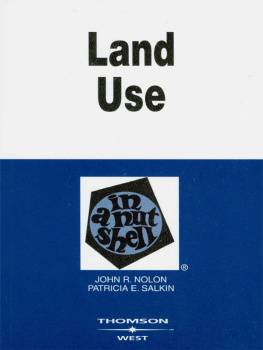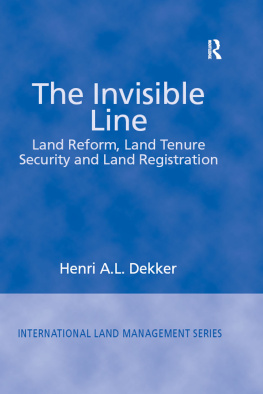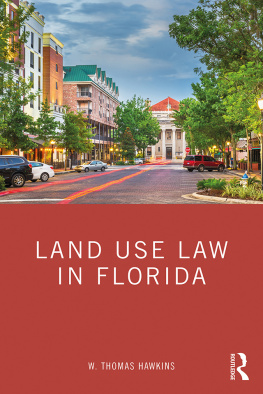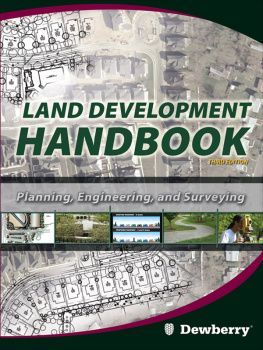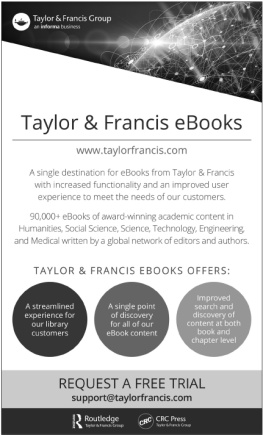
About Island Press
Since 1984, the nonprofit organization Island Press has been stimulating, shaping, and communicating ideas that are essential for solving environmental problems worldwide. With more than 800 titles in print and some 40 new releases each year, we are the nations leading publisher on environmental issues. We identify innovative thinkers and emerging trends in the environmental field. We work with world-renowned experts and authors to develop cross-disciplinary solutions to environmental challenges.
Island Press designs and executes educational campaigns in conjunction with our authors to communicate their critical messages in print, in person, and online using the latest technologies, innovative programs, and the media. Our goal is to reach targeted audiencesscientists, policymakers, environmental advocates, urban planners, the media, and concerned citizensxwith information that can be used to create the framework for long-term ecological health and human well-being.
Island Press gratefully acknowledges major support of our work by The Agua Fund, The Andrew W. Mellon Foundation, Betsy & Jesse Fink Foundation, The Bobolink Foundation, The Curtis and Edith Munson Foundation, Forrest C. and Frances H. Lattner Foundation, G.O. Forward Fund of the Saint Paul Foundation, Gordon and Betty Moore Foundation, The Kresge Foundation, The Margaret A. Cargill Foundation, The Overbrook Foundation, The S.D. Bechtel, Jr. Foundation, The Summit Charitable Foundation, Inc., V. Kann Rasmussen Foundation, The Wallace Alexander Gerbode Foundation, and other generous supporters.
The opinions expressed in this book are those of the author(s) and do not necessarily reflect the views of our supporters.
Land Use and Society
Land Use and Society
Geography, Law, and Public Policy
Third Edition
Rutherford H. Platt

Washington | Covelo | London
Copyright 2014, 2004, 1996 Rutherford H. Platt
All rights reserved under International and Pan-American Copyright Conventions. No part of this book may be reproduced in any form or by any means without permission in writing from the publisher: Island Press, 2000 M Street, NW, Suite 650, Washington, DC 20036
Island Press is a trademark of Island Press/The Center for Resource Economics.
Library of Congress and CIP Data
Platt, Rutherford H., author.
Land use and society : geography, law, and public policy / by Rutherford H. Platt. -- Third Edition.
pages cm
Includes bibliographical references and index.
ISBN 978-1-61091-453-6 (cloth : alk. paper) -- ISBN 1-61091-453-8 (cloth : alk. paper) -- ISBN 978-1-61091-454-3 (pbk. : alk. paper) -- ISBN 1-61091-454-6 (pbk. : alk. paper) 1. Land use-
Law and legislation--United States. 2. Land use--United States. 3. Physical geography--United States. I. Title.
KF5698.P588 2014
346.73045--dc23
2013042593
Keywords: floodplains, humane metropolis, land use geography, land use law, land use regulation, local governance, property ownership, public health and safety regulations, smart growth, suburban sprawl, takings issue, water resource management, urban design, urban planning, urban renewal, wetlands, zoning regulations
Contents
TO JACK, ELIZABETH, LUCY, AND ELIOT
Grandchildren who are above average!
Acknowledgments
Many people have contributed, directly and indirectly, to this third edition of Land Use and Society: Geography, Law, and Public Policy. First and foremost, I thank Heather Boyer, senior editor at Island Press, who once again has expertly and cheerfully guided me through the labyrinth of the book revision process. I appreciate her timely and useful feedback on editorial matters as well as her broad knowledge of the urban sustainability literature. Also at Island Press, production editor Sharis Simonian has kept the entire book revision on track, and Rebecca Bright, editorial assistant, has been enormously helpful in overseeing the art elements of the book.
Once again, I thank Kathleen M. Lafferty as editorial advisor, copy editor, and dear friend for her unfailing technical skill, patience, and sense of humor in this our fourth book collaboration. I am also grateful to Don Sluter of the Department of Geosciences at the University of Massachusetts Amherst for his help in redrafting certain diagrams and figures. Barbara Fell-Johnson, director of the Hampshire County Law Library, vetted on legal citations.
Although I have technically retired from the University of Massachusetts Amherst, some of my former students now educate me in their respective areas of professional expertise, particularly Joy Abbott, Miriam Anderson, Nancy Denig, Jim Kendra, Peter Klejna, Bill Nechamen, Laurin Sievert, and Aaron Wieneth.
I also thank many colleagues and friends around the country who are helping promote greener, healthier, safer, and more humane urban communities, especially Jerry Adelmann, Will Allen, Tim Beatley, Armando Carbonell, Chris De Sousa, Peter Harnik, Mike Houck, Jon Kusler, Larry Larson, Roland Lewis, Mary Rickel Pelletier, Alex Polikoff, Ann Riley, Anne Spirn, Kathleen Tierney, Cathy Tumber, and Bob Yaro, among many others.
Introduction
Geography, Law, and Landscape: Reflections from 30,000 Feet
To geographers and their fellow travelers, there are few greater treats than to fly a considerable distance over land on a clear day with a view unobstructed by the airplane wing. Let us imagine an idealized flight from San Francisco to Boston. Between the sourdough vendors and live lobster purveyors of those two airports stretch about 2,700 miles of air distance. Along the way, the route traverses a succession of geographic regions marked by vivid contrasts in terrain, vegetation, land use, and extent of urban development. Even the casual observer can scarcely fail to notice and perhaps wonder about the diversity of geographic landscapes, both physical features such as deserts, mountain ranges, and plains as well as human patterns of rural and urban land use. The window-gazer may attempt to annotate the passing scene with speculation about what accounts for the extreme variation in what is seen or imagined in the landscapes below. Such speculation is thinking geographically.
The aircraft ascends over the crowded East Bay cities of Oakland and Berkeley, where world-class scholarship and abject poverty coexist. The hills and flatlands are riddled with seismic faults that caused the Nimitz Freeway to collapse in the October 17, 1989, earthquake and where 3,300 homes burned in the hills two years later. Beyond the Coastal Range, we fly high above the geometric patterns of irrigated fields of the Central Valley, which like the Imperial Valley to the south is handsomely subsidized by the federal taxpayer. Next we hurtle over the high peaks and steep declivities of the Sierra Nevada, where wilderness defender John Muir battled Gifford Pinchot, the first director of the U.S. Forest Service, over damming the Hetch Hetchy Valley to supply water for San Francisco after the 1906 fire. (Muir lost that one, but proposals to undam Hetch Hetchy surface from time to time.) As of 2013, record-breaking drought in western states was shrinking mountain snowpack, reducing reservoir levels, and threatening water supplies for cities, irrigation, hydropower, recreation, fisheries, and aquatic ecosystems. We streak across the sandy wastes of the Great Basin, where early nuclear weapons were tested and a vast underground complex for storing nuclear wastes at Yucca Mountain remains unused due to endless political debate. Cities and irrigated agriculture reappear in the Mormon settlement region east of Great Salt Lake. The Wasatch Range, with its ski slopes and patches of clear-cutting in national forests, gives way to the upper Colorado River Plateau, another sparsely inhabited region of high desert, sagebrush, and spectacular landforms. Downstream on the Colorado River, the one-armed geologist and geographer John Wesley Powell made his epic journey through the Grand Canyon in 1869 that stimulated his proposals for large-scale irrigation projects in the arid West. We pass near Dinosaur National Park, where Echo Dam, one of Powells proposed projects, was defeated by David Brower, who picked up Muirs antidam sentiment in the 1950s at the dawn of the modern environmental movement.
Next page







